
dnk
-
Content Count
578 -
Joined
-
Last visited
-
Medals
Posts posted by dnk
-
-
-
Steam means I can't lose a game. It also is a very nice and easy service for keeping games up to date and maintaining data file integrity (which I can f with on occasion, and it helps being able to one-click fix an installation whereas before it was a full uninstall/reininstall hassle). I don't love it, but I use it for most everything now, and just accept the online requirements as they come since it doesn't cause me issues 99% of the time.
-
Blastcore, while not like 200% better, is clearly better by a good bit. Whatever the case, vanilla's FX really need an improvement.
-
Do note that the primary thread only uses one core, and that's the thread that's bottlenecking the game so hooorribly. Simulation-AI-render, all on one thread, one core. They certainly have multithreaded it and moved less significant things (eg PhysX) onto other cores, but the big stuff is still single-threaded. It's also why a headless client that takes the AI off the main thread can greatly improve performance. That's a hack that we shouldn't still be having to use to get true multithreaded performance out of this engine, though. They need to make that hack obsolete.
-
JSRS sounds were much louder across the board. Might be they need some volume leveling.
That aside, they sounded better about 90% of the time to me. SOS was also a clear improvement on vanilla.
-
I did? I don't recall doing that...
All I heard was some Scottish guy cursing for 2min. Is there an actual comparison in there somewhere?
-
I can't see much of a performance difference between none-SSAO-HDAO. They're all +/- 3% FPS.
-
Check servers subforum or the wiki. I'm sure it's somewhere around here...
-
I was referencing specifically Arma's boot times as "got more money than you need", didn't realize we'd expanded out into general computing. If you mean Windows and general computing, then yes it's worthwhile. For a long, long time hard drives have been the slowest component and increasing their speed would show the best increase in "responsivity", program loading, etc, assuming RAM and CPU were up to spec already. I'm looking forward to my full reinstall tomorrow quite eagerly. That was the primary reason for the purchase. Adding a lot of perceived smoothness to Arma is the cherry on top (and it does seem to be quite better subjectively, even if it's not so great an improvement objectively).
-
Frankly, if you're willing to spend $100+ to shave 5sec off your load times, you've got more money than you need, and you should give me some to thank me for my report :P
-
Oh, you can also play the mission in MP, host it on a dedi server, then play it by yourself. Not sure if this is for SP, but that will load the AI off onto a separate core/thread.
-
Get a faster/better CPU, otherwise you could reduce object/terrain quality or VD, that would take some of the load off of the CPU. I mean, 5KM VD is massive, especially with the higher object quality settings. Do note that you're not expected to be able to run Ultra settings (and 5km is ultra as it gets) in this game with hundreds of AI. Until the devs rewrite the engine to make AI run in parallel on multiple cores, you're stuck.
As you increase the number of AI, you increase the amount of computation required on the main thread running on its single core, and this thread is the limiting factor for FPS for most players (and for you in this scenario, clearly). The longer this thread takes each frame, the slower the frame, because this is the bottleneck for your system. Reducing IQ or VD will help because this same thread also handles draw calls, which are decreased with decreasing scene geometry (lowered object/terrain IQ and VD).
I don't know why you need more than 100 active AI, but if that's what you want, well, that's the deal. Drop your settings, drop the number of AI, or drop some money on a high-end overclocked processor.
-
The FPS are definitely smoother IF you're using high quality textures/models. If not, it doesn't do much. It depends heavily on your IQ settings and actual system if it's a must-have or not. Someone with a GTS 250 like I had before... not a must-have. I'm still not convinced it was worth $100 (only talking about Arma and not general computing) compared to how much the rest of my system cost - the $130 I spent on the 650 Ti-B yielded vastly superior improvements than the SSD, and I'd imagine a new i7 4xxx would likewise yield better than 3x the improvements of the SSD (at 3x the price). Even more RAM probably would, though that's a bit more of a gray area.
-
@Sniperwolf572 RE: Scenario and Processing
For the original tests, I ran the following scenario;
http://i482.photobucket.com/albums/rr181/davidk594/arma32014-02-2020-04-40-65_zps7dc9bfe1.png (365 kB)
For the previous tests, I would run through this mission one time before benchmarking at the lowest IQ settings, then ran each after that in sequence without performing any flushes or program restarts. For the newest tests below, I ran through one time to preload everything, then one time again to benchmark (this is why the newest comparison test has a smaller difference, since both the HDD and SDD had already loaded almost all the textures to VRAM on the first run-through, so there wasn't much to do on the second run-through).
The markers are the 7 different locations that the script setpos'd the player's chopper to every 7 seconds. The player enters the chopper as a passenger, then switches to 3rd person view, then hits zoom in. Then the chopper flies around Kavala. After each setpos, I would quickly pan 180-degrees and back. In Kavala, I kept the camera centered on the hospital, with a couple specifically timed occasions when I would do a quick 180-degree pan.
For benchmarking, I used FRAPS' benchmark with frametimes selected. After finishing, I opened it in a spreadsheet and took the delta time for each frame (FRAPS sets them as cumulative, which is not very useful for a graph). Then I put the HDD and SSD data together and made a chart from them. For the "ordered" charts, I just copied the values, pasted them as numbers (not formulas), and used data->sort on each, then graphed them.
Really, it must be another hardware issue, because the SSD offers no real FPS advantage I've seen.
NEW TESTS
Rig:
(this has changed!)
Intel i5 3350P 4c @3.3GHz (stock) 32-32-256-6M caches
Gigabyte B75M mATX board (current BIOS)
Gigabyte 650 Ti BOOST 2GB GDDR5 192-bit 900/1500MHz core/memory
2x2 GB OCZ 1066MHz 7-7-7-16 DC DDR3 (moderate latency, low bandwidth)
WD 7200RPM 1TB HDD SATA3
vs
Corsair Force LS 120GB SSD SATA3 (current firmware)
FIFTH TEST
This was a copy of the old scenario with the new GPU and new settings.
Settings:
HIGH + 2500VD
Texture: very high
Objects: high
Terrain: high
Shadow: ultra
Particles: high
Cloud: high
PIP: off
HDR: standard
Dyn Lights: ultra
VD: 2500/2500/200
1600x900
16xAF 8xAA "Low" HDAO ATOC all trees+grass, caustics on
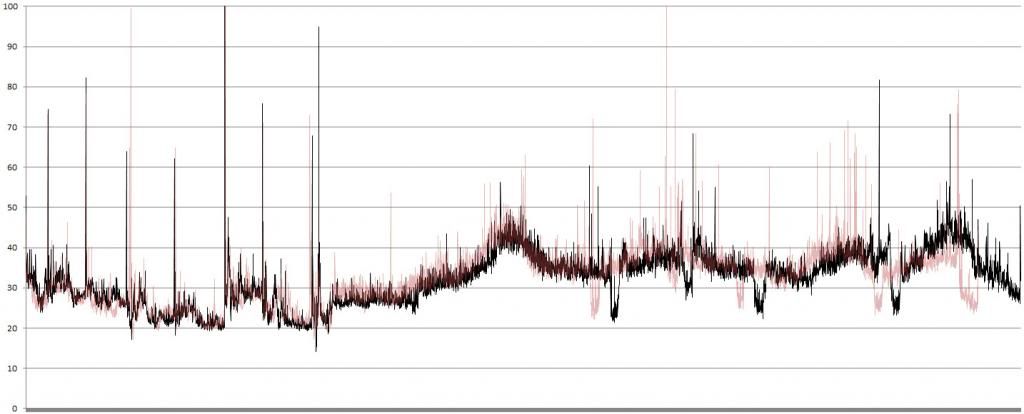
Black is SSD, pink is HDD.
Here, I preloaded all the textures/objects by running through the mission once before testing. As you can see, this reduces the SSD's edge over the HDD considerably, especially with a new 2GB VRAM video card (which never goes past 1.2-1.4GB of usage but whatever, it's more) to store it all in. Still, there's considerably less hanging after each sudden setpos movement for the SSD.
In Kavala, the two are fairly similar, though the SSD has fewer lag spikes overall and what it does have are half to a quarter as bad as the HDD.
Average FPS of SSD vs HDD: 31.6 v 31.2
SIXTH TEST
Settings:
HIGH + 2500VD (same as above)
Texture: very high
Objects: high
Terrain: high
Shadow: ultra
Particles: high
Cloud: high
PIP: off
HDR: standard
Dyn Lights: ultra
VD: 2500/2500/200
1600x900
16xAF 8xAA "Low" HDAO ATOC all trees+grass, caustics on
Scenario: player takes a 2x time speed chopper ride from Pyrgos, around the island, and drops in to Kavala, where he runs around a set course, quickly panning and zooming in constantly. This is meant to approximate a plane ride and typical infantry combat movements in a major city. This was done right after the prior test, so most textures/models should have been preloaded already. If that was not the case, I would expect the HDD to perform significantly worse as it did on tests 1-4.
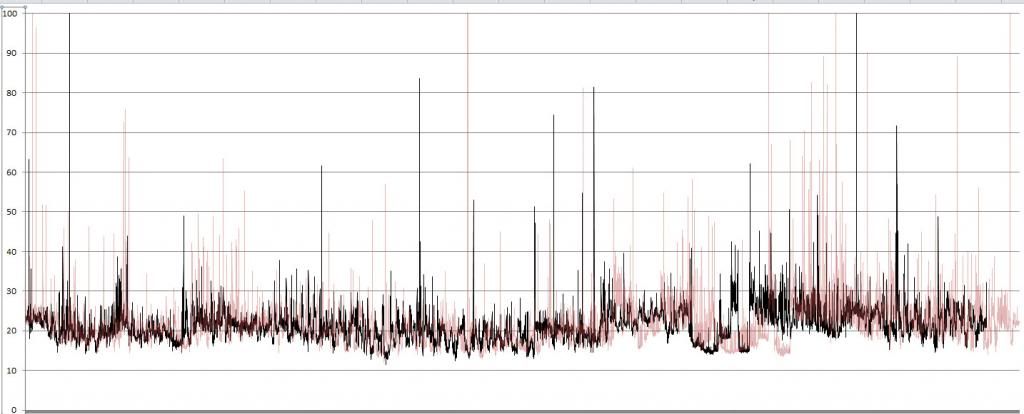
Black is SSD, pink is HDD
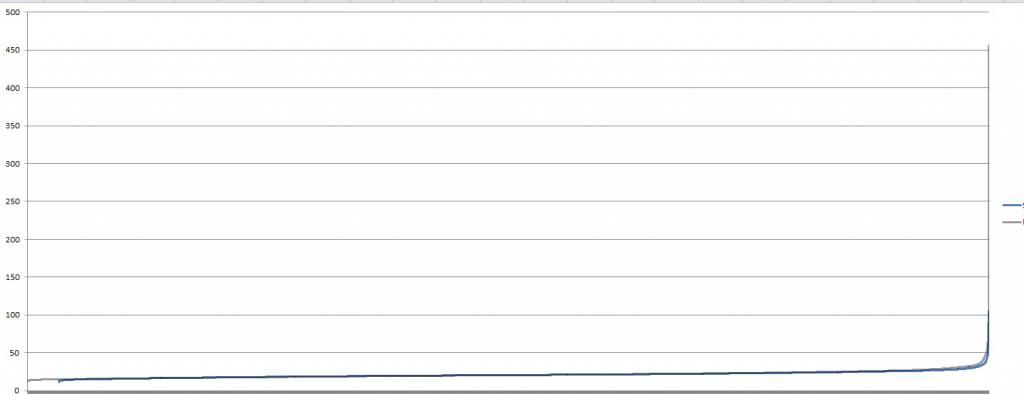
Black is HDD, Blue is SSD
First, other than a very few major lag spikes, neither drive has a clear "low end performance" problem here. Additionally, the HDD and SSD have very similar stutter performance while flying over the island - no clear winner there, though most textures/objects had been preloaded in both cases. However, the HDD clearly struggles a LOT more in terms of stutters in the last half, when the chopper gets to Kavala and the player gets out and runs around on foot. Here, the SSD clearly offers far smoother gameplay.
Total frames above 40ms for SSD and HDD: 0.3% vs 0.6%.
Worst frames for SSD (in ms): 104, 103, 83, 81, 74, 71, 63, 62, 61, 56...
Worst frames for HDD (in ms): 456, 179, 104, 103, 102, 96, 90, 89, 89...
The SSD's frequence of stutters is perhaps half as much as the HDD, and the severity also is roughly half. And this was in a test that was as biased in favor of the HDD as possible, with all textures being preloaded. We've seen how badly the HDD does when the bias is shifted in the SSD's favor, so it's only fair.
Avg FPS of SSD vs HDD: 47.7 v 47.6
-
I'd prefer environmental effects on sound (reverb, muffling, etc for different environments) over occlusion, given how short most sounds play already. Oh, and adjustments for pitch/etc based on position (front/side/rear).
-
I've seen very few blatant cheats, and I'm not one to go around yelling "hacker!" every time someone kills me, so I disagree. This is over like 300 hours of play so far, mostly KOTH and Breaking Point.
I mean, really, extremely few cheats in competitive PvP MP (but I avoid Russian servers).
-
4GB is all I need for this game, and before people jump up and say, "no, it can utilize blahblahGB of RAM!" recognize that I watch my RAM usage after finishing, and I've yet to see total physical usage go past 3GB out of 3.95 available. The RAM is low bandwidth, but I'm fairly sure the VRAM streams direct from disk, so that shouldn't matter. The CPU is middle-of-the-road (but limited for Arma, yes) - for any other FPS it'd be more than adequate for 60FPS. The GPU has now been replaced by a 650 Ti Boost (yay!).
I wouldn't expect many players to build a system just around this game, when so many other games prioritize the GPU over the CPU and more RAM over a faster hard drive. Now, I'm totally undoubtedly CPU limited with just a mediocre 650 Ti Boost, like 60-70% core usage. Given the lack of graphical polish, there's just nothing for the GPU to do but dawdle and wait for a better graphical game to get played. This isn't really news, though, and I wholly expected it.
Anyway, I've started testing with the new GPU and much higher settings. Report coming soon. First thing I've noticed is that the GPU doesn't use more than like 1.2GB of RAM (it's 2GB total), meaning I have almost a full GB there too that's not being utilized, so instead the VRAM keeps going up and down as memory management does minor purges and loads. Ancient engine is ancient.
I'll also do another test once I've moved the Windows and pagefile over to the SSD to see if that does anything.
-
^ exactly. This is why I never fully trust FPS numbers from Arma benchmarks, especially when done just once. There's always like a +/-10%. It might actually be like 4% in the SSD's favor, hopefully further testing will get it more accurate.
I have noticed that with all the reduced stuttering, I can increase my texture quality from low to high without a significant performance impact (due to said stutters), which is a huge IQ improvement since I would get huge hangs and long frames before on the WD with anything other than low (very high still hangs too much, but with another 1GB in the GPU it probably wouldn't, but right now there's too much memory management going on with just the 1GB).
MP seems a lot smoother now, but that might just be my brain playing tricks, trying to justify the thing. Unfortunately with MP, there are so many more variables to control that it's damn-near impossible to do a benchmark.
-
Got a new SSD and figured why not do some benchmarking. I created a simple fairly script-less mission on Altis with 120 AI. To specifically test the SDD, I made the first part of the mission have the player setpos across the map to 8 different locations every 7 seconds, while I panned left and right after each move (the first pan right would load everything, the return pan left would look back over what was loaded). Then I had the player flown over Kavala for a couple minutes as I kept my view squarely on the hospital, with a couple quick pans out at specific locations. It should be easy to see on the graphs when the mission switched from the setpos script to the flyover.
Rig:
Intel i5 3350P 4c @3.3GHz (stock) 32-32-256-6M caches
Gigabyte B75M mATX board (current BIOS)
BFG GTS 250 1GB GDDR3 256-bit 738MHz/1100MHz core/memory (current drivers) (yes, this is a horrid GPU that's 12hours away from retirement)
2x2 GB OCZ 1066MHz 7-7-7-16 DC DDR3 (moderate latency, low bandwidth)
WD 7200RPM 1TB HDD SATA3
vs
Corsair Force LS 120GB SSD SATA3 (current firmware)
Expectations:
I expected minimal differences in FPS overall, with far fewer and lower stutters on the SSD (which would be the reason for whatever average FPS differences were seen). I expected the SSD would have far lower max frametimes than the HDD, and the SSD would do far better on the scripted setpos part of the mission with little to no pop-in.
Results:
Basically what was expected.
In each graph, the green is the SSD and the red is the old magnospinner.
The first graph is the frametimes, the inverse of FPS - higher is bad. 100 = 10FPS, 500 = 2FPS. The second graph is all the frames in order from fastest to slowest, again high = bad.
FIRST TEST
Settings:
LOW + 2000VD
Texture: low
Objects: low
Terrain: low
Shadow: ultra
Particles: low
Cloud: low
PIP: off
HDR: low
Dyn Lights: low
VD: 2000/2000/200
1600x900
Nothing but full AF for the last tab
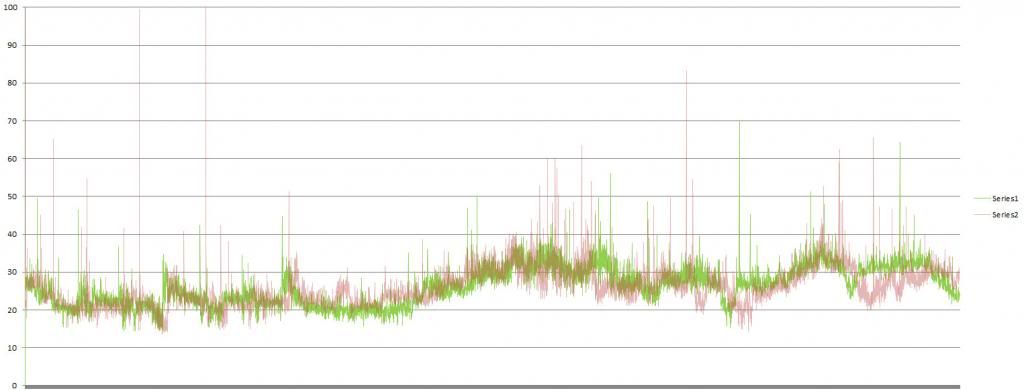
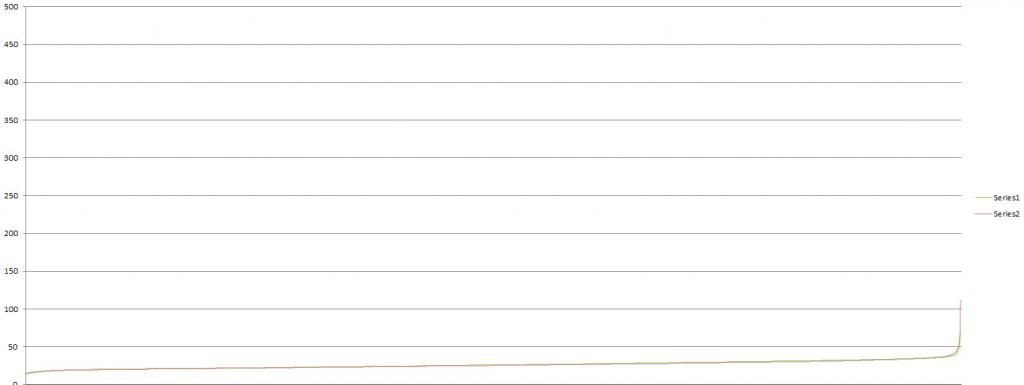
In overall FPS neither is the clear winner; actually, the spinner looks a bit faster, but that's almost certainly variance at work. Already, though, the SSD is showing fewer stutters, especially in Kavala, but also far faster load-in for the setpos sudden moves. Still, overall they're basically the same.
SECOND TEST
Settings:
LOW + 3500VD
Texture: low
Objects: low
Terrain: low
Shadow: ultra
Particles: low
Cloud: low
PIP: off
HDR: low
Dyn Lights: low
VD: 3500/3500/200
1600x900
Nothing but full AF for the last tab
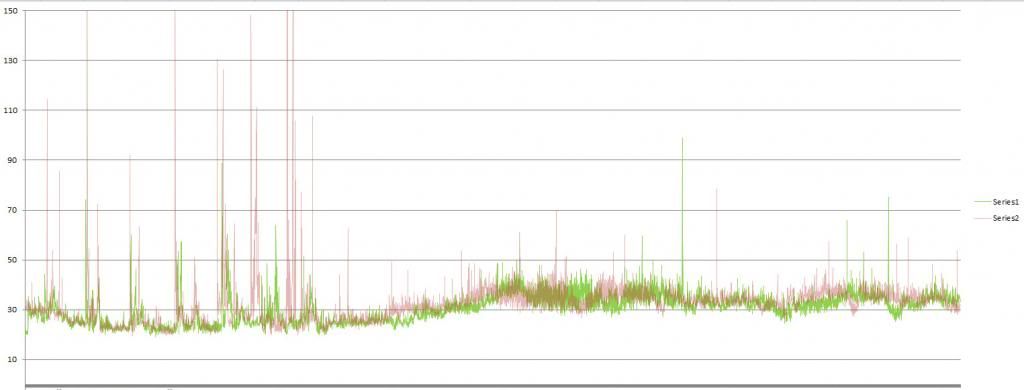
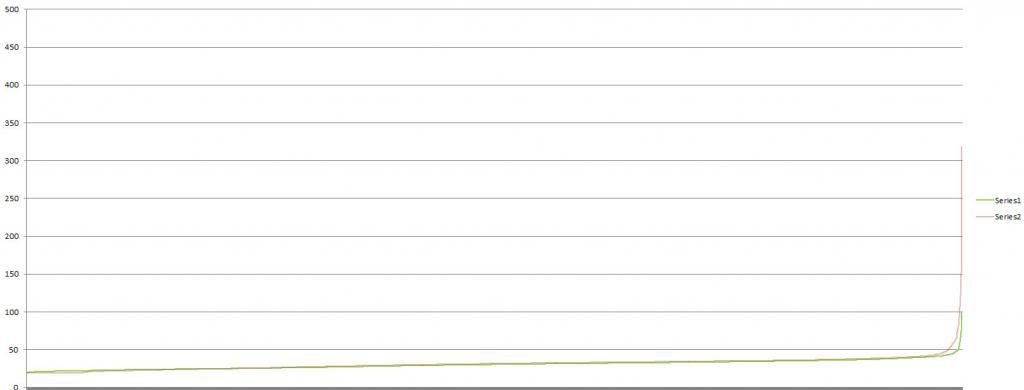
Now, here's a stark difference when it comes to the setpos sudden mass loads. The SSD does a much better job of streaming in all the data quickly, with far less stuttering. There's still quite visible pop-in, but the SSD clears it within 1-2 frames each time, while the WD struggles frame after frame to stream in all that crap. In Kavala during the flyover, though, both drives are basically the same, with the SSD getting hit hard by a sudden turn in the middle.
THIRD TEST
Settings:
High + 2000VD
Texture: high
Objects: high
Terrain: high
Shadow: ultra
Particles: low
Cloud: high
PIP: off
HDR: standard
Dyn Lights: low
VD: 2000/2000/200
1600x900
Nothing but full AF for the last tab
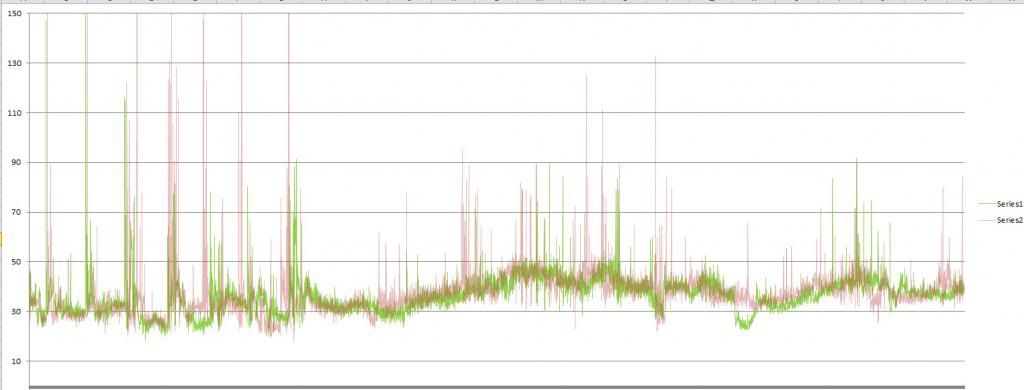

Here, there's clearly a bigger difference in average FPS in Kavala (and the WD just fails at the setpos portion), though this may be random luck. While the SSD still loses a few frames occasionally, the WD is clearly constantly struggling to keep up, and it should show up in lowered average FPS by a smidge as well.
FINAL TEST
Settings:
High + 3500VD
Texture: high
Objects: high
Terrain: high
Shadow: ultra
Particles: low
Cloud: high
PIP: off
HDR: standard
Dyn Lights: low
VD: 3500/3500/200
1600x900
Nothing but full AF for the last tab
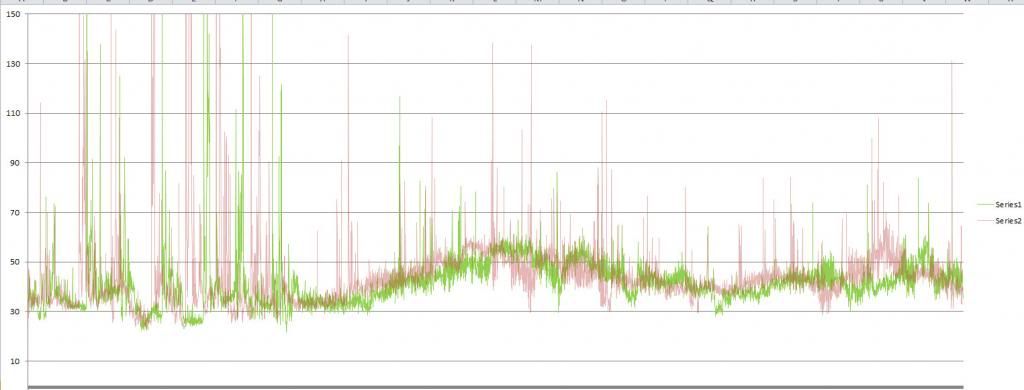
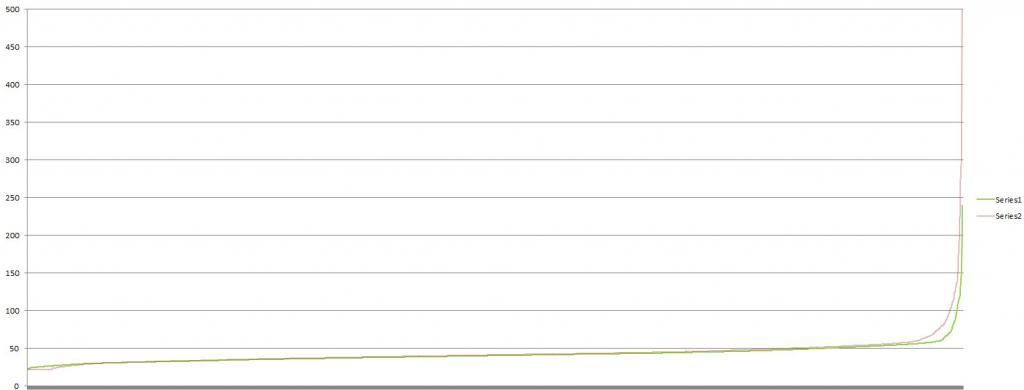
Here, there's not a clear overall FPS winner, but the SSD crushes the WD in the fast loading part. I'm going to go a bit more indepth, since this is where we should see the biggest difference. The longest frame for the WD is 540ms (less than 2FPS), with 15 being under 5FPS, very noticeable stutters, if not breaks in the game. By comparison, the SSD has only 3 frames under 5FPS (all just under that), and the 15th longest frame is 120ms (which is the same as the 40th longest for the WD).
Looking solely at the Kavala flyover, ignoring the quickload tests, there's a clear favorite in the SSD:
Time under FPS for SSD, for WD, ratio
10FPS - 0.03% - 0.3% :: 10:1
15FPS - 0.6% - 1.9% :: 3:1
20FPS - 17% - 21% :: 1.25:1
33FPS - 91% - 95% :: ~1:1
AVG SSD = 42.9FPS
AVG WD = 44.7FPS
Conclusion
Well, there's random luck at play. It's doubtful such a long, AI-heavy (for me) scenario would yield perfect results, and with just 1 run-through we're likely to get a noisy result. But it's clear that if there's any overall FPS gain from an SSD, it's miniscule. The real difference is in reducing stutters and stutter amplitude and in quick loading (the latter isn't very important usually, though). Going from having serious stutters 2% of the time to just a quarter as much is going to feel better, and having massive game-stopping stutters all but disappear is pretty huge since those happen all too frequently on the WD. However, I doubt it's worth the pricetag of an SSD just for that since the $100+ could be better spent on faster RAM (see this thread), saving up for a better CPU or GPU, or you know, hookers and blow.
Still, if you were considering an SSD for other uses or just general computing, it probably will be worth it to put Arma on the drive.
-
You've got a 4.9GHz here, which the vast majority of players don't have. It also doesn't look like there's much of a difference between 1600 and 2133.
I mean, the difference in latency between the fastest and slowest is a 38% reduction, which goes with a 17% reduction in avg frame times and 20% for minimum frames (meaning roughly a 50% ratio between RAM speed increases and FPS increases, which is still significant enough to justify a new purchase for players with old slow RAM).
However, it seems like once you reached a certain threshold for your system (1600/C10) your minimum frame times didn't improve with anything faster, while your averages continued on improving. Now, if you have a much slower processor (most players), that plateau point for min FPS might be considerably lower, and the avg FPS increases might be less than here (50% of RAM speed increase) as well.
So would a 3.9GHz or 2.9GHz require even 1600MHz RAM for best performance, or would 1333 or even 1066 work just fine for each, respectively?
-
I always carry 6 smokes. Especially when there's a revive script, they're life savers.
-
This looks awesomer than expected, and it fulfills a long-held community wish for a real-time 3D editor.
I suppose that's worth the hype.
-
Why can't we holster handguns again?
-
Mosquito storm.
They're going to implement mosquito models in the game to add to the insect life.
Get yer bugspray.
J.S.R.S Vs Speed of Sound. Video 1 - YOU decided
in ARMA 3 - GENERAL
Posted